radiator cap DODGE JOURNEY 2017 1.G Owners Manual
[x] Cancel search | Manufacturer: DODGE, Model Year: 2017, Model line: JOURNEY, Model: DODGE JOURNEY 2017 1.GPages: 510
Page 406 of 510
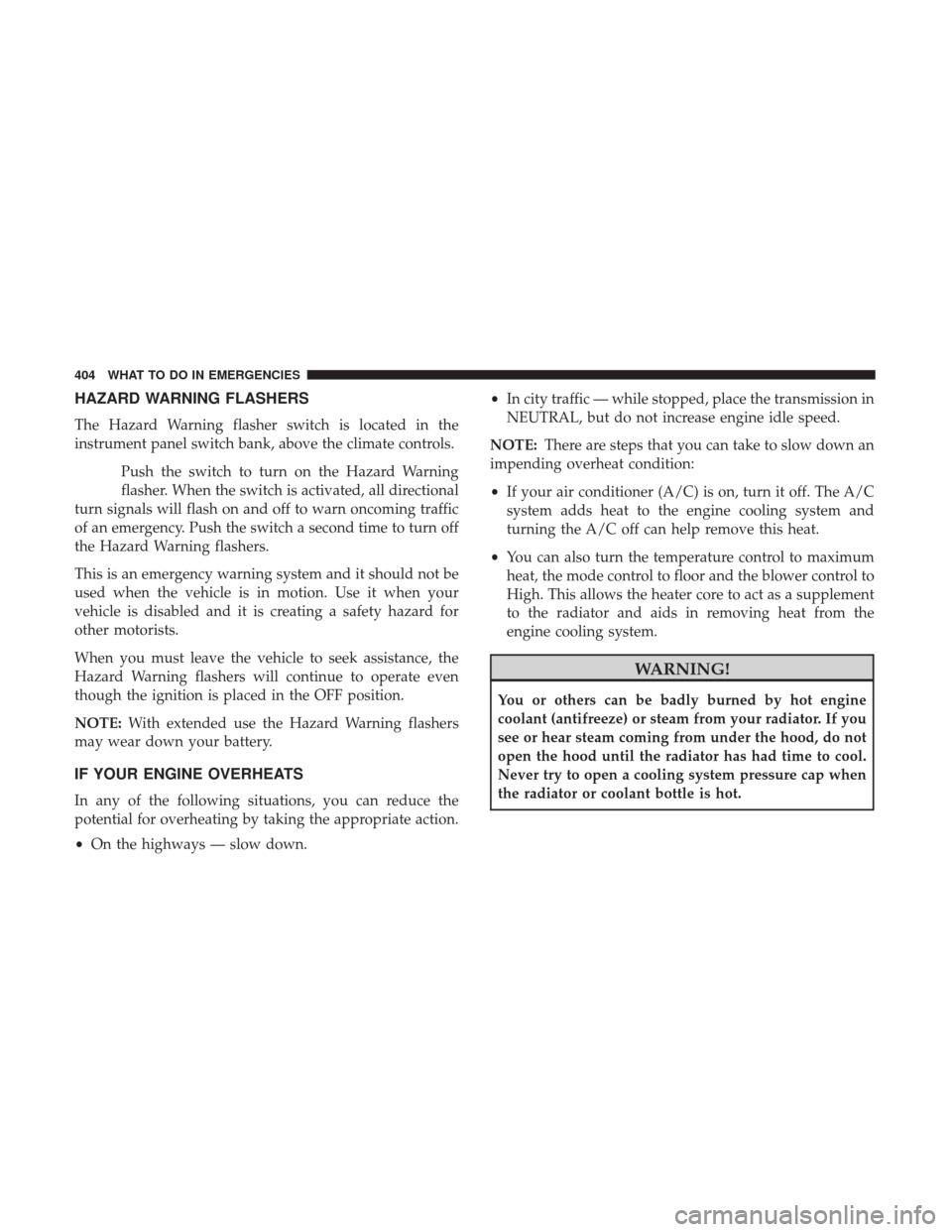
HAZARD WARNING FLASHERS
The Hazard Warning flasher switch is located in the
instrument panel switch bank, above the climate controls.Push the switch to turn on the Hazard Warning
flasher. When the switch is activated, all directional
turn signals will flash on and off to warn oncoming traffic
of an emergency. Push the switch a second time to turn off
the Hazard Warning flashers.
This is an emergency warning system and it should not be
used when the vehicle is in motion. Use it when your
vehicle is disabled and it is creating a safety hazard for
other motorists.
When you must leave the vehicle to seek assistance, the
Hazard Warning flashers will continue to operate even
though the ignition is placed in the OFF position.
NOTE: With extended use the Hazard Warning flashers
may wear down your battery.
IF YOUR ENGINE OVERHEATS
In any of the following situations, you can reduce the
potential for overheating by taking the appropriate action.
• On the highways — slow down. •
In city traffic — while stopped, place the transmission in
NEUTRAL, but do not increase engine idle speed.
NOTE: There are steps that you can take to slow down an
impending overheat condition:
• If your air conditioner (A/C) is on, turn it off. The A/C
system adds heat to the engine cooling system and
turning the A/C off can help remove this heat.
• You can also turn the temperature control to maximum
heat, the mode control to floor and the blower control to
High. This allows the heater core to act as a supplement
to the radiator and aids in removing heat from the
engine cooling system.
WARNING!
You or others can be badly burned by hot engine
coolant (antifreeze) or steam from your radiator. If you
see or hear steam coming from under the hood, do not
open the hood until the radiator has had time to cool.
Never try to open a cooling system pressure cap when
the radiator or coolant bottle is hot.
404 WHAT TO DO IN EMERGENCIES
Page 420 of 510
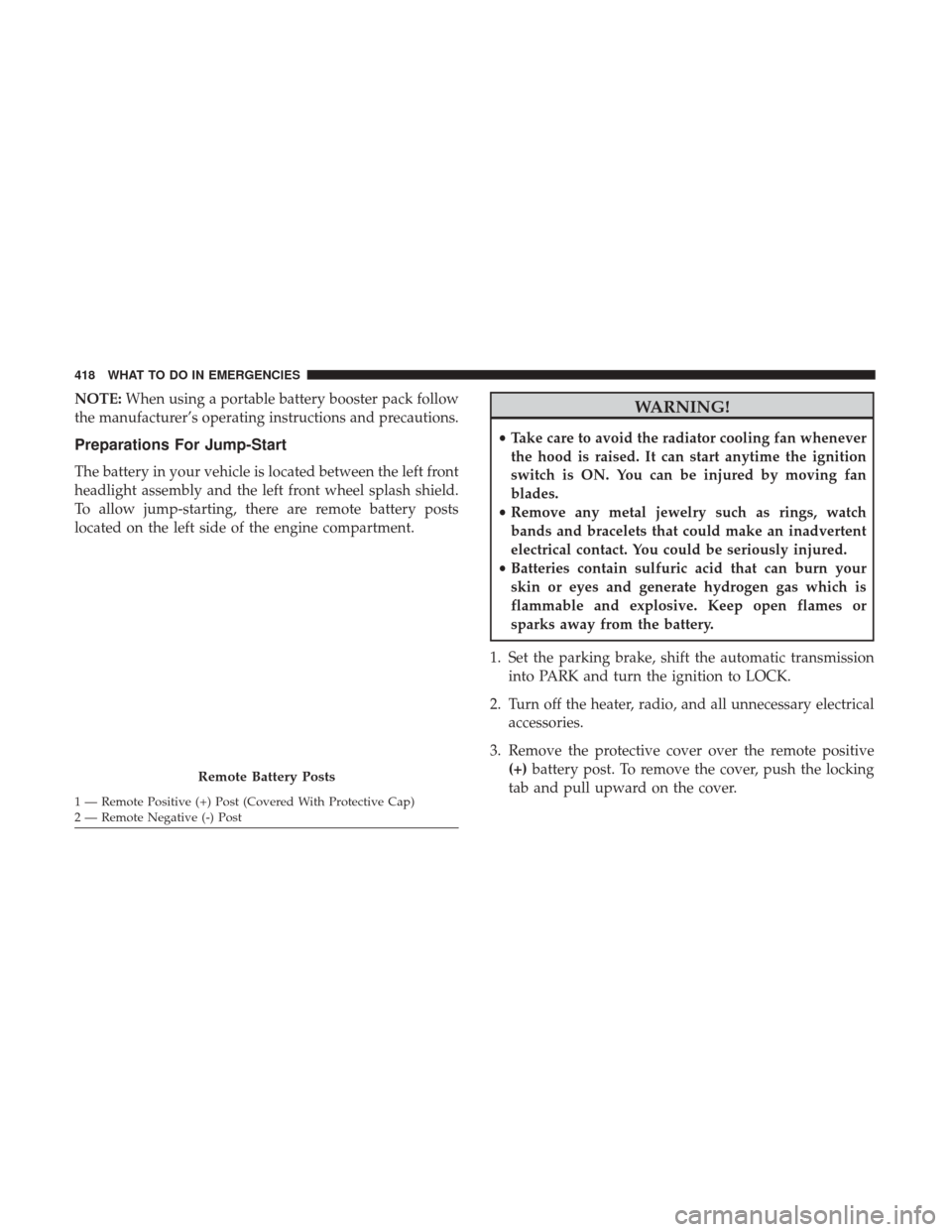
NOTE:When using a portable battery booster pack follow
the manufacturer’s operating instructions and precautions.
Preparations For Jump-Start
The battery in your vehicle is located between the left front
headlight assembly and the left front wheel splash shield.
To allow jump-starting, there are remote battery posts
located on the left side of the engine compartment.
WARNING!
• Take care to avoid the radiator cooling fan whenever
the hood is raised. It can start anytime the ignition
switch is ON. You can be injured by moving fan
blades.
• Remove any metal jewelry such as rings, watch
bands and bracelets that could make an inadvertent
electrical contact. You could be seriously injured.
• Batteries contain sulfuric acid that can burn your
skin or eyes and generate hydrogen gas which is
flammable and explosive. Keep open flames or
sparks away from the battery.
1. Set the parking brake, shift the automatic transmission into PARK and turn the ignition to LOCK.
2. Turn off the heater, radio, and all unnecessary electrical accessories.
3. Remove the protective cover over the remote positive (+) battery post. To remove the cover, push the locking
tab and pull upward on the cover.
Remote Battery Posts
1 — Remote Positive (+) Post (Covered With Protective Cap)
2 — Remote Negative (-) Post 418 WHAT TO DO IN EMERGENCIES
Page 445 of 510
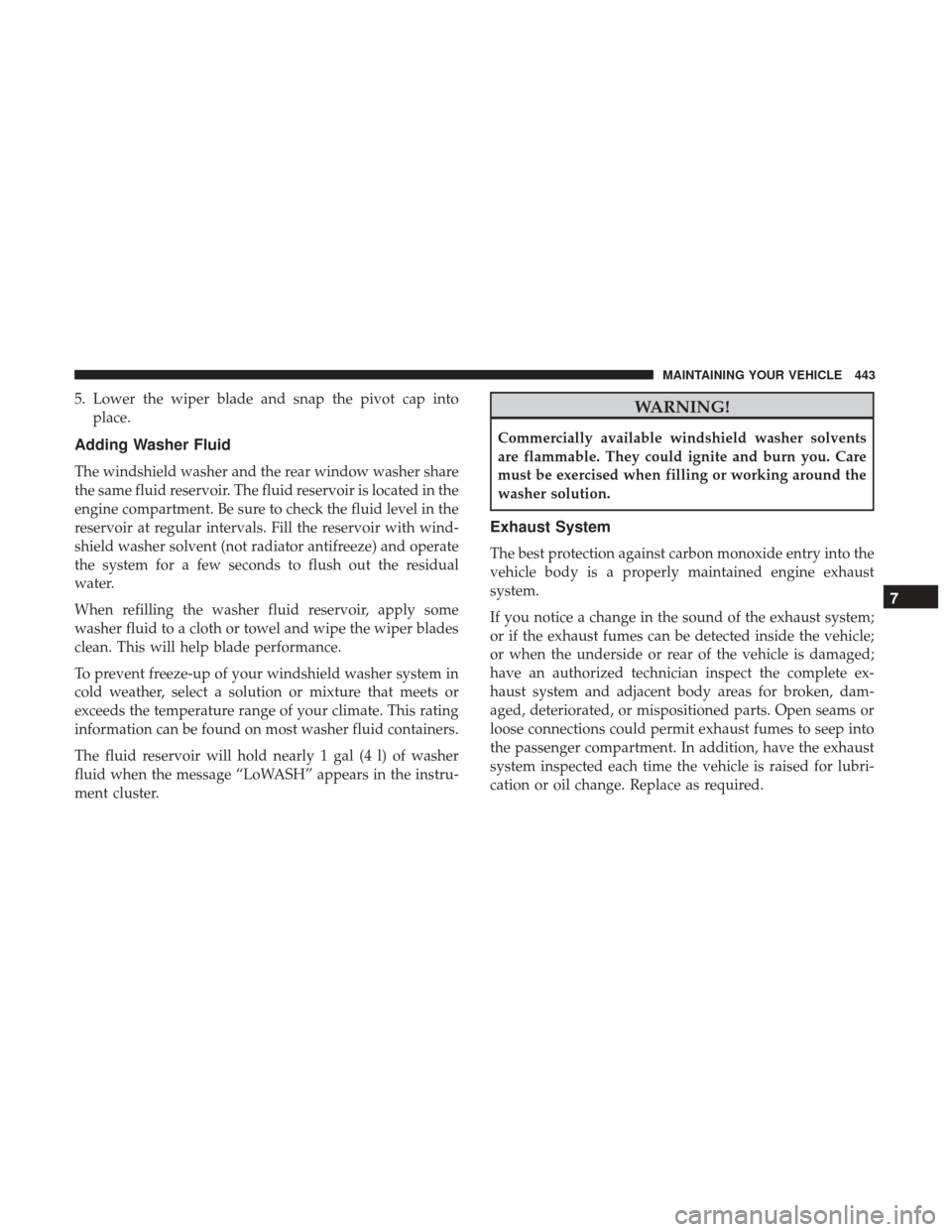
5. Lower the wiper blade and snap the pivot cap intoplace.
Adding Washer Fluid
The windshield washer and the rear window washer share
the same fluid reservoir. The fluid reservoir is located in the
engine compartment. Be sure to check the fluid level in the
reservoir at regular intervals. Fill the reservoir with wind-
shield washer solvent (not radiator antifreeze) and operate
the system for a few seconds to flush out the residual
water.
When refilling the washer fluid reservoir, apply some
washer fluid to a cloth or towel and wipe the wiper blades
clean. This will help blade performance.
To prevent freeze-up of your windshield washer system in
cold weather, select a solution or mixture that meets or
exceeds the temperature range of your climate. This rating
information can be found on most washer fluid containers.
The fluid reservoir will hold nearly 1 gal (4 l) of washer
fluid when the message “LoWASH” appears in the instru-
ment cluster.
WARNING!
Commercially available windshield washer solvents
are flammable. They could ignite and burn you. Care
must be exercised when filling or working around the
washer solution.
Exhaust System
The best protection against carbon monoxide entry into the
vehicle body is a properly maintained engine exhaust
system.
If you notice a change in the sound of the exhaust system;
or if the exhaust fumes can be detected inside the vehicle;
or when the underside or rear of the vehicle is damaged;
have an authorized technician inspect the complete ex-
haust system and adjacent body areas for broken, dam-
aged, deteriorated, or mispositioned parts. Open seams or
loose connections could permit exhaust fumes to seep into
the passenger compartment. In addition, have the exhaust
system inspected each time the vehicle is raised for lubri-
cation or oil change. Replace as required.
7
MAINTAINING YOUR VEHICLE 443
Page 447 of 510
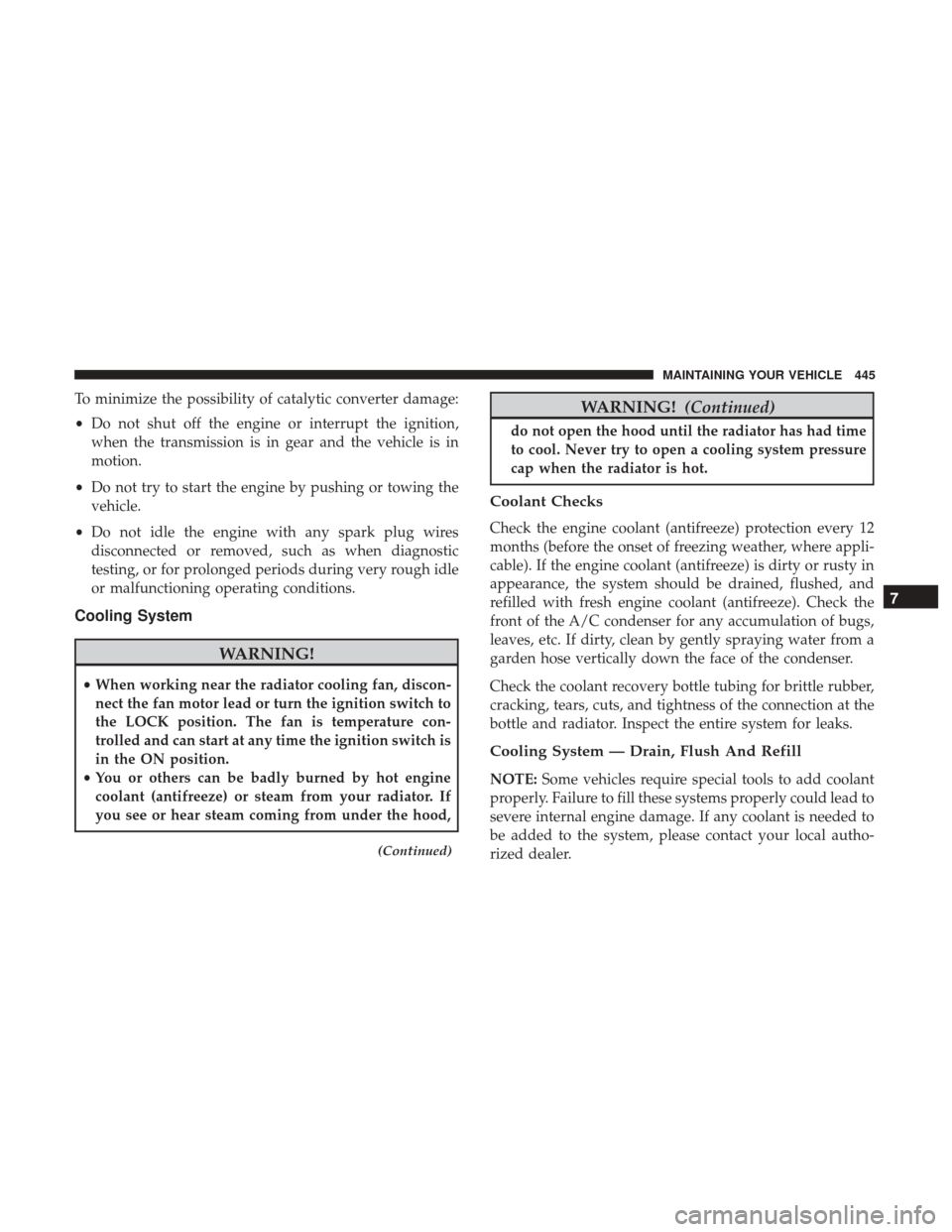
To minimize the possibility of catalytic converter damage:
•Do not shut off the engine or interrupt the ignition,
when the transmission is in gear and the vehicle is in
motion.
• Do not try to start the engine by pushing or towing the
vehicle.
• Do not idle the engine with any spark plug wires
disconnected or removed, such as when diagnostic
testing, or for prolonged periods during very rough idle
or malfunctioning operating conditions.
Cooling System
WARNING!
• When working near the radiator cooling fan, discon-
nect the fan motor lead or turn the ignition switch to
the LOCK position. The fan is temperature con-
trolled and can start at any time the ignition switch is
in the ON position.
• You or others can be badly burned by hot engine
coolant (antifreeze) or steam from your radiator. If
you see or hear steam coming from under the hood,
(Continued)
WARNING! (Continued)
do not open the hood until the radiator has had time
to cool. Never try to open a cooling system pressure
cap when the radiator is hot.
Coolant Checks
Check the engine coolant (antifreeze) protection every 12
months (before the onset of freezing weather, where appli-
cable). If the engine coolant (antifreeze) is dirty or rusty in
appearance, the system should be drained, flushed, and
refilled with fresh engine coolant (antifreeze). Check the
front of the A/C condenser for any accumulation of bugs,
leaves, etc. If dirty, clean by gently spraying water from a
garden hose vertically down the face of the condenser.
Check the coolant recovery bottle tubing for brittle rubber,
cracking, tears, cuts, and tightness of the connection at the
bottle and radiator. Inspect the entire system for leaks.
Cooling System — Drain, Flush And Refill
NOTE:Some vehicles require special tools to add coolant
properly. Failure to fill these systems properly could lead to
severe internal engine damage. If any coolant is needed to
be added to the system, please contact your local autho-
rized dealer.
7
MAINTAINING YOUR VEHICLE 445
Page 449 of 510
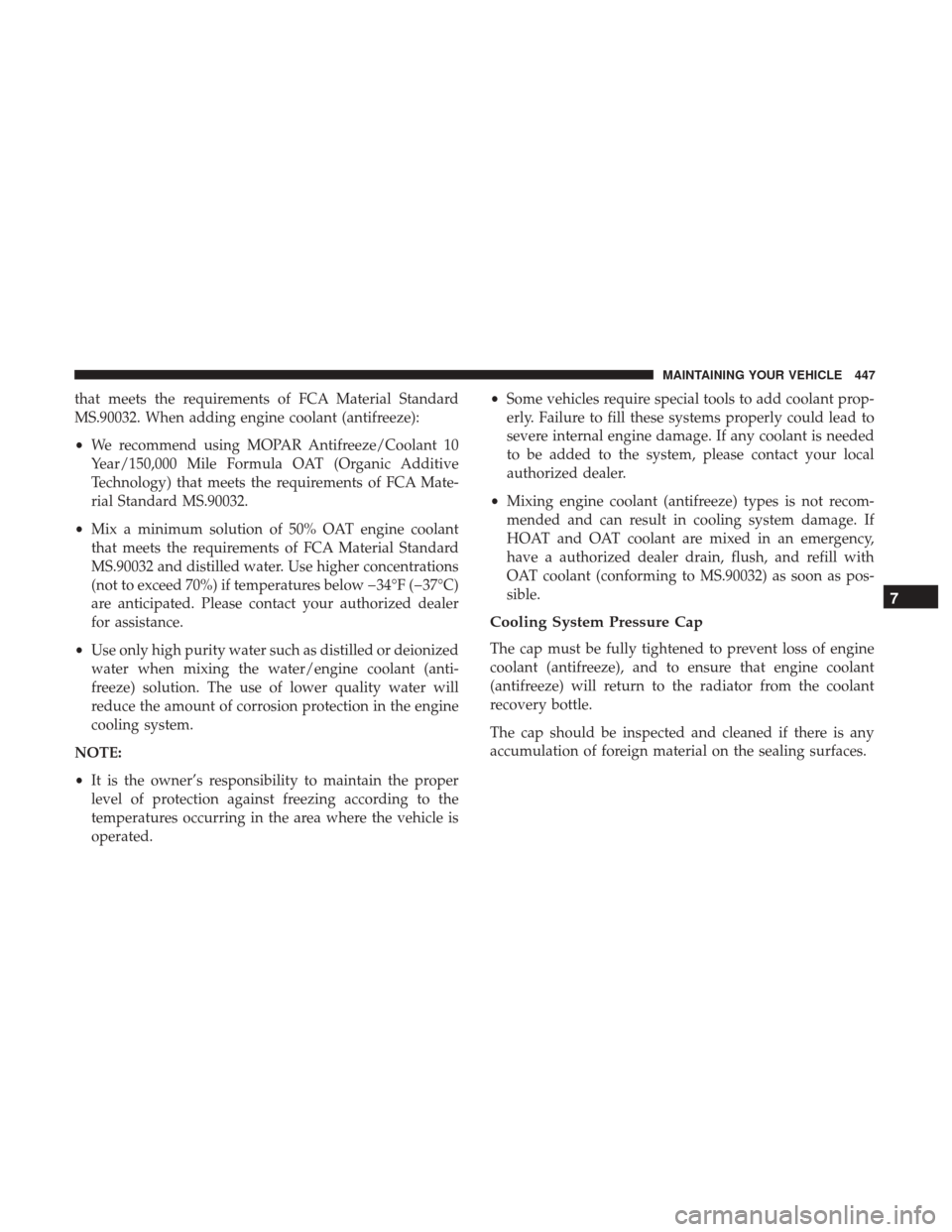
that meets the requirements of FCA Material Standard
MS.90032. When adding engine coolant (antifreeze):
•We recommend using MOPAR Antifreeze/Coolant 10
Year/150,000 Mile Formula OAT (Organic Additive
Technology) that meets the requirements of FCA Mate-
rial Standard MS.90032.
• Mix a minimum solution of 50% OAT engine coolant
that meets the requirements of FCA Material Standard
MS.90032 and distilled water. Use higher concentrations
(not to exceed 70%) if temperatures below �34°F (�37°C)
are anticipated. Please contact your authorized dealer
for assistance.
• Use only high purity water such as distilled or deionized
water when mixing the water/engine coolant (anti-
freeze) solution. The use of lower quality water will
reduce the amount of corrosion protection in the engine
cooling system.
NOTE:
• It is the owner’s responsibility to maintain the proper
level of protection against freezing according to the
temperatures occurring in the area where the vehicle is
operated. •
Some vehicles require special tools to add coolant prop-
erly. Failure to fill these systems properly could lead to
severe internal engine damage. If any coolant is needed
to be added to the system, please contact your local
authorized dealer.
• Mixing engine coolant (antifreeze) types is not recom-
mended and can result in cooling system damage. If
HOAT and OAT coolant are mixed in an emergency,
have a authorized dealer drain, flush, and refill with
OAT coolant (conforming to MS.90032) as soon as pos-
sible.
Cooling System Pressure Cap
The cap must be fully tightened to prevent loss of engine
coolant (antifreeze), and to ensure that engine coolant
(antifreeze) will return to the radiator from the coolant
recovery bottle.
The cap should be inspected and cleaned if there is any
accumulation of foreign material on the sealing surfaces.
7
MAINTAINING YOUR VEHICLE 447
Page 450 of 510
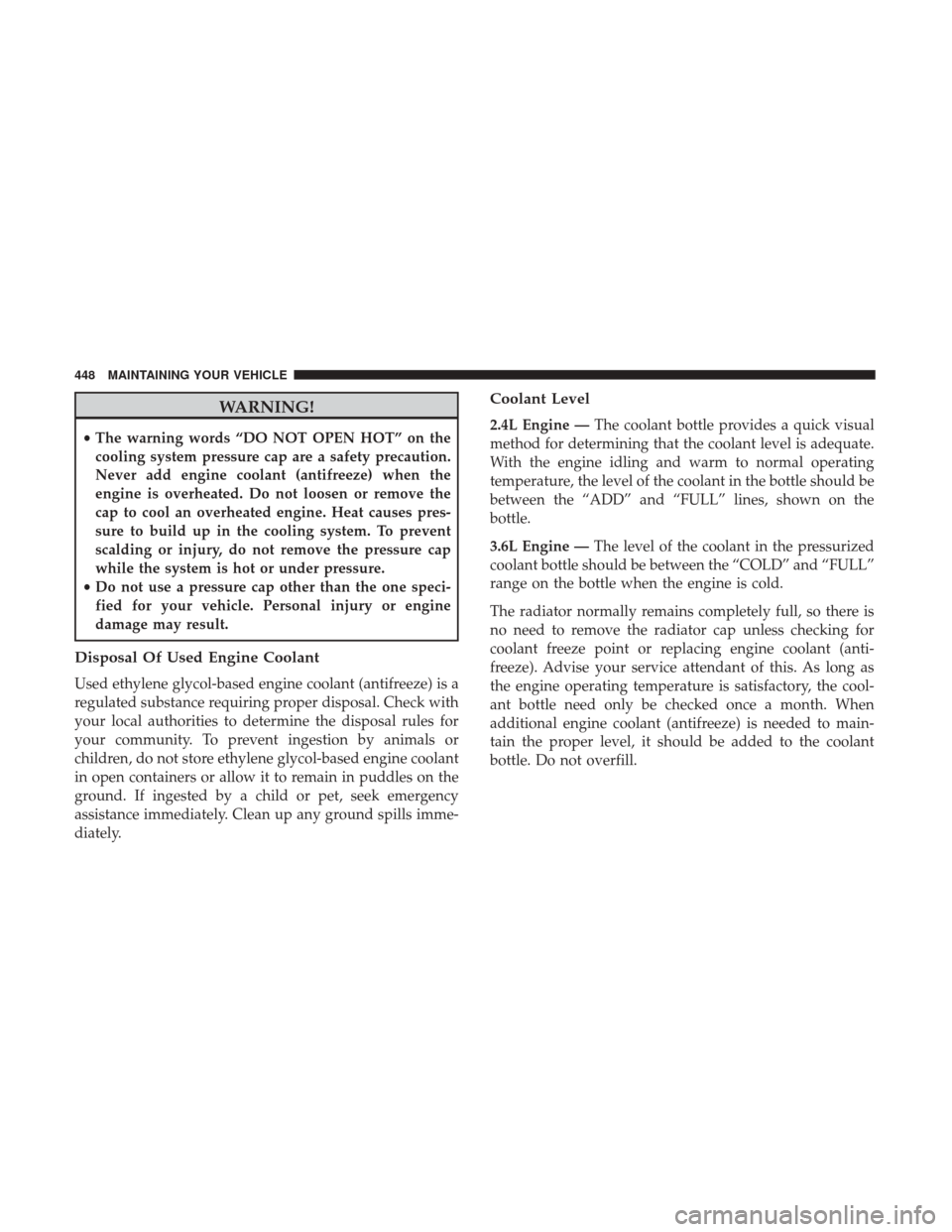
WARNING!
•The warning words “DO NOT OPEN HOT” on the
cooling system pressure cap are a safety precaution.
Never add engine coolant (antifreeze) when the
engine is overheated. Do not loosen or remove the
cap to cool an overheated engine. Heat causes pres-
sure to build up in the cooling system. To prevent
scalding or injury, do not remove the pressure cap
while the system is hot or under pressure.
• Do not use a pressure cap other than the one speci-
fied for your vehicle. Personal injury or engine
damage may result.
Disposal Of Used Engine Coolant
Used ethylene glycol-based engine coolant (antifreeze) is a
regulated substance requiring proper disposal. Check with
your local authorities to determine the disposal rules for
your community. To prevent ingestion by animals or
children, do not store ethylene glycol-based engine coolant
in open containers or allow it to remain in puddles on the
ground. If ingested by a child or pet, seek emergency
assistance immediately. Clean up any ground spills imme-
diately.
Coolant Level
2.4L Engine — The coolant bottle provides a quick visual
method for determining that the coolant level is adequate.
With the engine idling and warm to normal operating
temperature, the level of the coolant in the bottle should be
between the “ADD” and “FULL” lines, shown on the
bottle.
3.6L Engine — The level of the coolant in the pressurized
coolant bottle should be between the “COLD” and “FULL”
range on the bottle when the engine is cold.
The radiator normally remains completely full, so there is
no need to remove the radiator cap unless checking for
coolant freeze point or replacing engine coolant (anti-
freeze). Advise your service attendant of this. As long as
the engine operating temperature is satisfactory, the cool-
ant bottle need only be checked once a month. When
additional engine coolant (antifreeze) is needed to main-
tain the proper level, it should be added to the coolant
bottle. Do not overfill.
448 MAINTAINING YOUR VEHICLE
Page 493 of 510
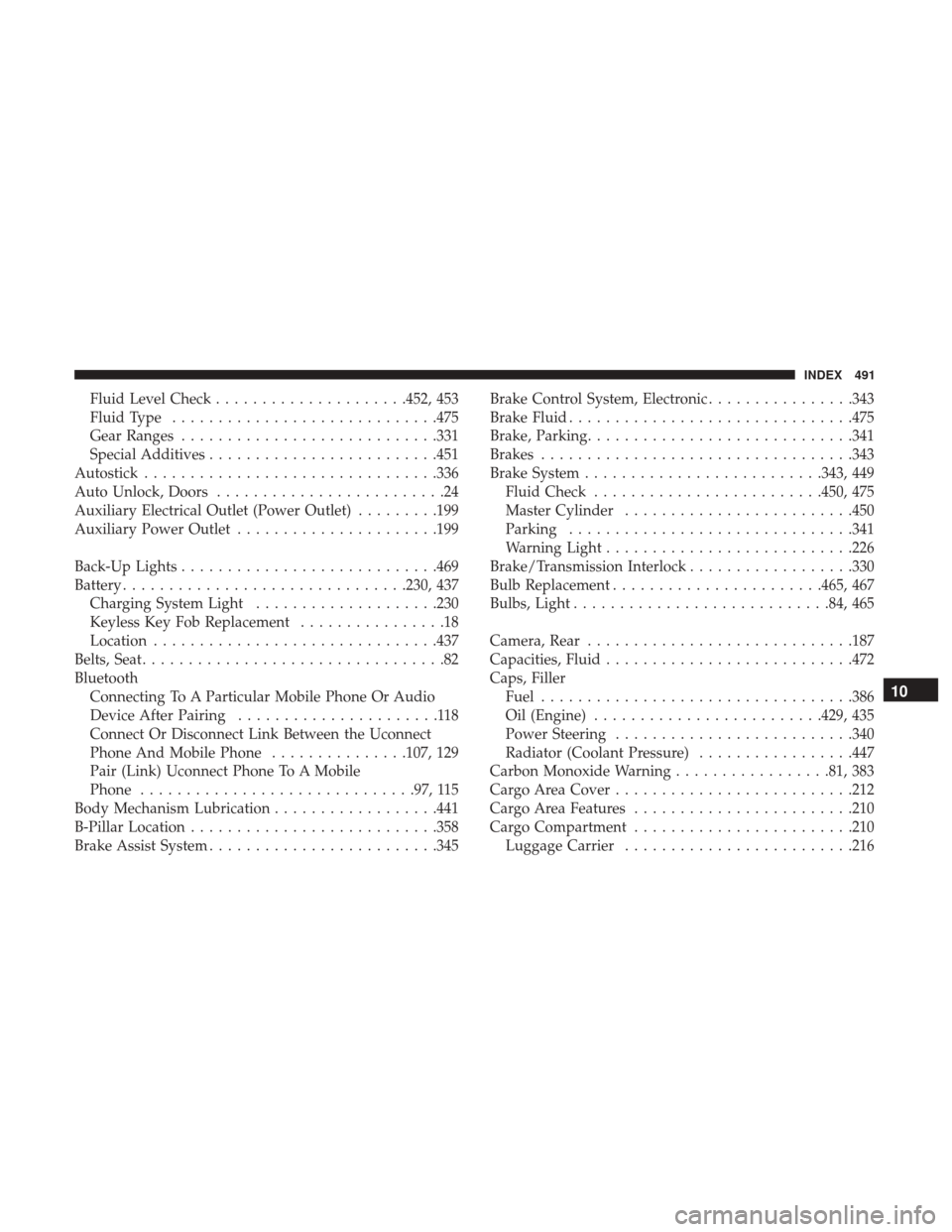
Fluid Level Check.....................452, 453
Fluid Type ............................ .475
Gear Ranges ........................... .331
Special Additives ........................ .451
Autostick ............................... .336
Auto Unlock, Doors .........................24
Auxiliary Electrical Outlet (Power Outlet) .........199
Auxiliary Power Outlet ..................... .199
Back-Up Lights ........................... .469
Battery .............................. .230, 437
Charging System Light ....................230
Keyless Key Fob Replacement ................18
Location .............................. .437
Belts, Seat .................................82
Bluetooth Connecting To A Particular Mobile Phone Or Audio
Device After Pairing ......................118
Connect Or Disconnect Link Between the Uconnect
Phone And Mobile Phone ...............107, 129
Pair (Link) Uconnect Phone To A Mobile
Phone ............................. .97, 115
Body Mechanism Lubrication ..................441
B-Pillar Location .......................... .358
Brake Assist System ........................ .345Brake Control System, Electronic
................343
Brake Fluid .............................. .475
Brake, Parking ............................ .341
Brakes ................................. .343
Brake System ......................... .343, 449
Fluid Check ........................ .450, 475
Master Cylinder ........................ .450
Parking .............................. .341
Warning Light .......................... .226
Brake/Transmission Interlock ..................330
Bulb Replacement ...................... .465, 467
Bulbs, Light ........................... .84, 465
Camera, Rear ............................ .187
Capacities, Fluid .......................... .472
Caps, Filler Fuel ................................. .386
Oil
(Engine) ........................ .429, 435
Power Steering ......................... .340
Radiator (Coolant Pressure) .................447
Carbon Monoxide Warning .................81, 383
Cargo Area Cover ......................... .212
Cargo Area Features ....................... .210
Cargo Compartment ....................... .210
Luggage Carrier ........................ .21610
INDEX 491
Page 494 of 510
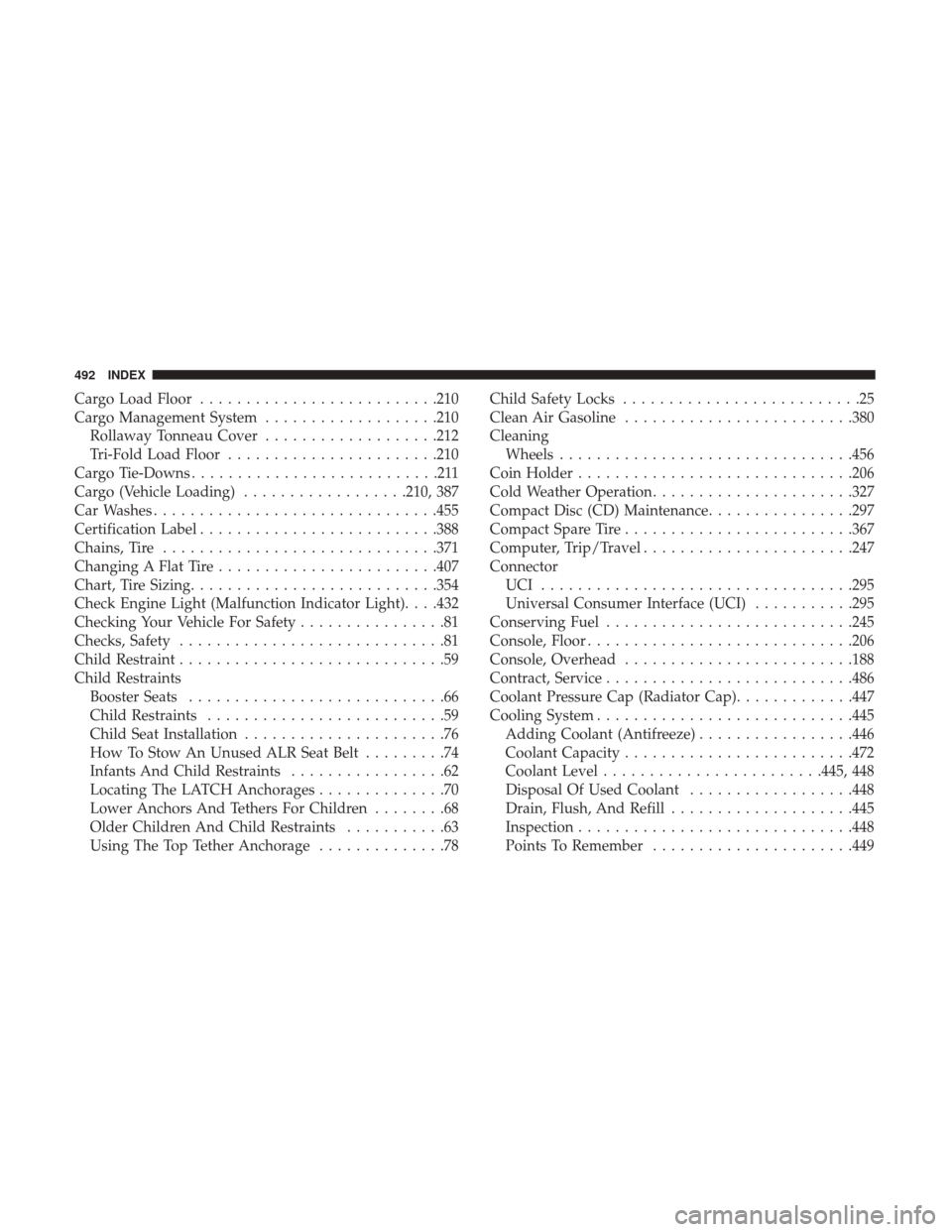
Cargo Load Floor......................... .210
Cargo Management System ...................210
Rollaway Tonneau Cover ...................212
Tri-Fold Load Floor ...................... .210
Cargo Tie-Downs ...........................211
Cargo (Vehicle Loading) ..................210, 387
Car Washes .............................. .455
Certification Label ......................... .388
Chains, Tire ............................. .371
Changing A Flat Tire ....................... .407
Chart, Tire Sizing .......................... .354
Check Engine Light (Malfunction Indicator Light). . . .432
Checking Your Vehicle For Safety ................81
Checks, Safety .............................81
Child Restraint .............................59
Child Restraints Booster Seats ............................66
Child Restraints ..........................59
Child Seat Installation ......................76
How To Stow An Unused ALR Seat Belt .........74
Infants And Child Restraints .................62
Locating The LATCH Anchorages ..............70
Lower Anchors And Tethers For Children ........68
Older Children And Child Restraints ...........63
Using The Top Tether Anchorage ..............78Child Safety Locks
..........................25
Clean Air Gasoline ........................ .380
Cleaning Wheels ............................... .456
Coin Holder ............................. .206
Cold Weather Operation ..................... .327
Compact Disc (CD) Maintenance ................297
Compact Spare Tire ........................ .367
Computer, Trip/Travel ...................... .247
Connector UCI ................................. .295
Universal Consumer Interface (UCI) ...........295
Conserving Fuel .......................... .245
Console, Floor ............................ .206
Console, Overhead ........................ .188
Contract, Service .......................... .486
Coolant Pressure Cap (Radiator Cap) .............447
Cooling
System........................... .445
Adding Coolant (Antifreeze) .................446
Coolant Capacity ........................ .472
Coolant Level ....................... .445, 448
Disposal Of Used Coolant ..................448
Drain, Flush, And Refill ....................445
Inspection ............................. .448
Points To Remember ..................... .449
492 INDEX
Page 495 of 510
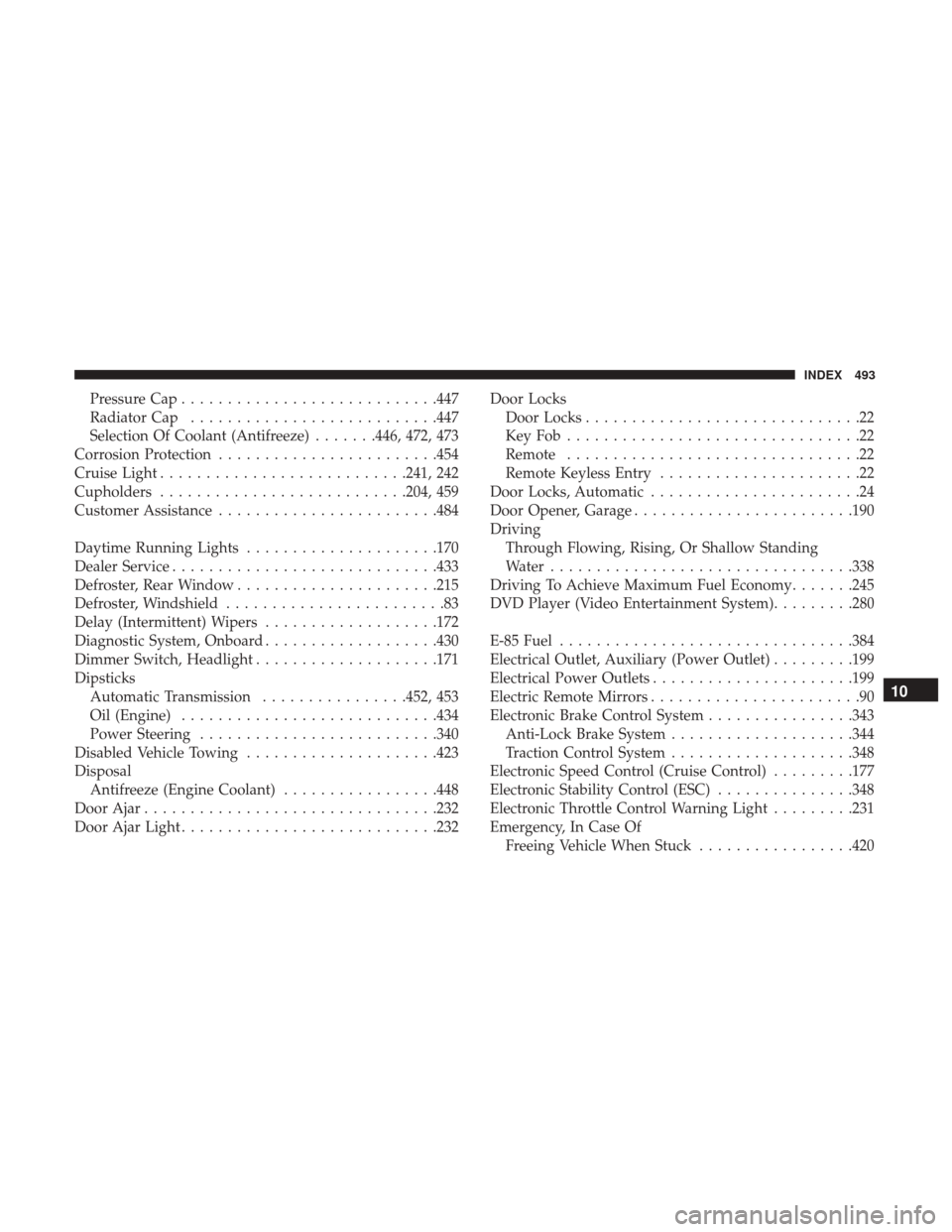
Pressure Cap........................... .447
Radiator Cap .......................... .447
Selection Of Coolant (Antifreeze) .......446, 472, 473
Corrosion Protection ....................... .454
Cruise Light .......................... .241, 242
Cupholders .......................... .204, 459
Customer Assistance ....................... .484
Daytime Running Lights .....................170
Dealer Service ............................ .433
Defroster, Rear Window ..................... .215
Defroster, Windshield ........................83
Delay (Intermittent) Wipers ...................172
Diagnostic System, Onboard ...................430
Dimmer Switch, Headlight ....................171
Dipsticks Automatic Transmission ................452, 453
Oil (Engine) ........................... .434
Power Steering ......................... .340
Disabled Vehicle Towing .....................423
Disposal Antifreeze (Engine Coolant) .................448
Door Ajar ............................... .232
Door Ajar Light ........................... .232Door Locks
Door Locks ..............................22
KeyFob................................22
Remote ................................22
Remote Keyless Entry ......................22
Door Locks, Automatic .......................24
Door Opener, Garage ....................... .190
Driving Through Flowing, Rising, Or Shallow Standing
Water ................................ .338
Driving To Achieve Maximum Fuel Economy .......245
DVD Player (Video Entertainment System) .........280
E-85 Fuel ............................... .384
Electrical Outlet, Auxiliary (Power Outlet) .........199
Electrical Power Outlets ..................... .199
Electric Remote Mirrors .......................90
Electronic Brake Control System ................343
Anti-Lock Brake System ....................344
T
raction Control System ....................348
Electronic Speed Control (Cruise Control) .........177
Electronic Stability Control (ESC) ...............348
Electronic Throttle Control Warning Light .........231
Emergency, In Case Of Freeing Vehicle When Stuck .................420
10
INDEX 493
Page 502 of 510
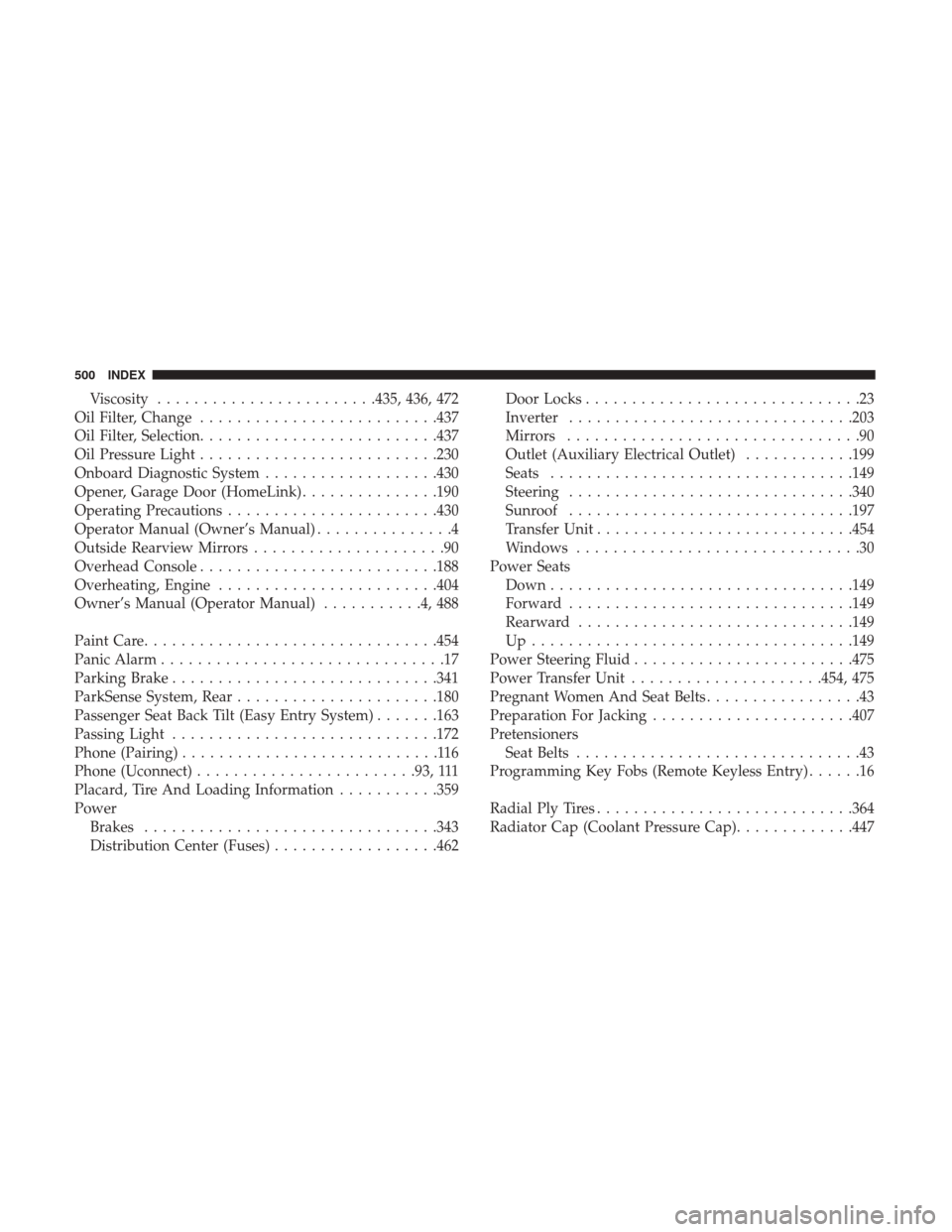
Viscosity....................... .435, 436, 472
Oil Filter, Change ......................... .437
Oil Filter, Selection ......................... .437
Oil Pressure Light ......................... .230
Onboard Diagnostic System ...................430
Opener, Garage Door (HomeLink) ...............190
Operating Precautions ...................... .430
Operator Manual (Owner’s Manual) ...............4
Outside Rearview Mirrors .....................90
Overhead Console ......................... .188
Overheating, Engine ....................... .404
Owner’s Manual (Operator Manual) ...........4,488
Paint Care ............................... .454
Panic Alarm ...............................17
Parking Brake ............................ .341
ParkSense System, Rear ..................... .180
Passenger Seat Back Tilt (Easy Entry System) .......163
Passing Light ............................ .172
Phone (Pairing) ............................116
Phone (Uconnect) ....................... .93, 111
Placard, Tire And Loading Information ...........359
Power Brakes ............................... .343
Distribution Center (Fuses) ..................462 Door Locks
..............................23
Inverter .............................. .203
Mirrors ................................90
Outlet (Auxiliary Electrical Outlet) ............199
Seats ................................ .149
Steering .............................. .340
Sunroof .............................. .197
Transfer Unit ........................... .454
Windows ...............................30
Power Seats Down ................................ .149
Forward .............................. .149
Rearward ............................. .149
Up.................................. .149
Power Steering Fluid ....................... .475
Power
Transfer Unit .....................454, 475
Pregnant Women And Seat Belts .................43
Preparation For Jacking ..................... .407
Pretensioners Seat Belts ...............................43
Programming Key Fobs (Remote Keyless Entry) ......16
Radial Ply Tires ........................... .364
Radiator Cap (Coolant Pressure Cap) .............447
500 INDEX